The Future of Medicine: Exploring Subscription Based Healthcare Designs
The Future of Medicine: Exploring Subscription Based Healthcare Designs
Blog Article
The Rise of Subscription-Based Medical Care and Its Effect on Patient Care
As healthcare progresses, the subscription-based version is getting traction, assuring to change individual care by supplying predictability and ease of access. The capacity for these designs to improve medical care delivery raises pressing inquiries regarding their long-term sustainability and inclusivity. Are these registration services the future of health care, or do they run the risk of leaving prone populations behind?
Recognizing Registration Medical Care Models
Comprehending the principle of subscription health care designs involves checking out a transformative method to medical solutions that emphasizes price and access. These models, usually described as straight primary treatment (DPC) or attendant medicine, have actually emerged as innovative alternatives to traditional fee-for-service healthcare systems. Subscription healthcare allows clients to pay a fixed regular monthly or annual charge for a specified set of clinical solutions, which might consist of unlimited workplace check outs, routine exams, and fundamental lab tests, without the demand for traditional insurance coverage payment.
The structure of membership health care designs is developed to simplify person care by removing third-party payers and intricate billing codes, thereby minimizing administrative problems. Doctor can focus a lot more on individual treatment, fostering more powerful patient-provider partnerships. This design likewise promotes preventative care by urging normal sees, as the monetary challenge of per-visit costs is eliminated.
The subscription version frequently equips doctor to manage smaller individual panels, enabling even more customized treatment. It lines up monetary incentives with individual health end results, as companies are encouraged to preserve person contentment and well-being. In general, recognizing membership health care models needs acknowledging their possible to reshape just how treatment is delivered and accessed.
Advantages for Individuals and Suppliers

For service providers, subscription-based versions supply the chance to deepen patient-provider relationships. With a consistent revenue stream, medical care experts can devote even more time to every individual, leading to a much more thorough and individualized care experience. This model likewise minimizes dependence on high individual quantities, easing burnout and improving task satisfaction. The emphasis on preventive treatment within registration strategies can lead to much better patient end results and lowered long-lasting healthcare expenses. By concentrating on continuous care, carriers can address issues before they intensify, ultimately profiting the medical care system as an entire by decreasing the burden on emergency and severe treatment solutions.
Issues and challenges
While subscription-based healthcare designs present many advantages, they additionally come with a collection of challenges and worries that should be dealt with. This increases ethical questions concerning equitable accessibility to health care services.
Financial sustainability of subscription-based models is an additional problem. Providers should stabilize the set revenue from registrations with the variable prices of health care services, which might rise and fall because of unexpected clinical needs. This can develop stress to limit solutions or increase costs, potentially affecting person fulfillment and care top quality.
In addition, regulatory oversight of subscription-based health care versions is still evolving. Attending to these obstacles is crucial for the successful and equitable application of subscription-based health care.
Influence On Patient-Doctor Relationships
One significant impact of subscription-based healthcare versions on patient-doctor relationships is the potential for enhanced continuity and personalized care. By embracing a membership design, medical professionals can handle a smaller sized individual panel, permitting even more committed time with each person. This raised schedule cultivates a much deeper understanding of a person's clinical background, way of life, and preferences, allowing much more tailored treatment strategies and treatments.

Nonetheless, it is necessary to acknowledge that while subscription-based models might benefit those that can afford them, they could accidentally broaden health care disparities. People who are unable to get involved in these designs might experience lower access to personalized treatment, possibly impacting their partnerships with health care companies. Thus, while the registration model supplies appealing benefits for patient-doctor connections, it additionally presents obstacles that need to be resolved to guarantee fair healthcare gain access to.
Future of Healthcare Gain Access To

The role of technology can not be overlooked in this transformation. Telemedicine platforms and digital health records assist in seamless communication between clients and doctor, breaking down logistical and geographical obstacles. In addition, innovations in expert system and information analytics can additionally customize treatment by predicting patient needs and optimizing therapy strategies.
Nevertheless, the future of medical care accessibility additionally offers difficulties, such as guaranteeing equity across various socio-economic groups. Policymakers and doctor have to work together my website to connect the digital divide, ensuring that subscription-based versions stay cost effective and inclusive. As these systems mature, they hold the assurance of making health care much more accessible, reliable, and patient-centric.
Verdict
Subscription-based healthcare models are reshaping client care by offering a steady expense structure and improving availability. The increase of subscription-based health care motivates positive individual interaction, see this here which has the possible to boost person end results and contentment, signifying a transformative change in medical care shipment.
As health care develops, the subscription-based model is gaining traction, assuring to reinvent individual care by providing predictability and ease of access.Subscription-based medical care versions provide distinct advantages for both providers and patients, boosting the general health care experience.As healthcare systems advance, the future of medical care gain access to frequently pivots on the combination of innovative versions and innovations.Subscription-based healthcare models are improving client treatment by providing a secure expense structure and boosting ease of access. The rise of subscription-based medical care motivates proactive individual engagement, which has the possible to enhance individual end results and fulfillment, signaling a transformative change in healthcare distribution.
Report this page